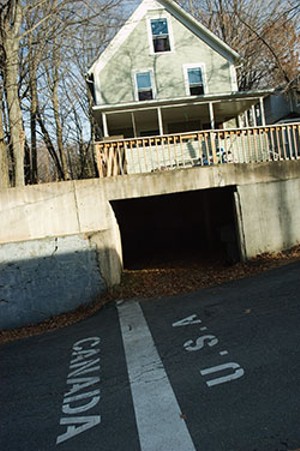Published November 18, 2009 at 8:33 a.m.
At the end of Maple Street in Derby Line, just before the roadway becomes rue Ball in Québec, stands a set of engraved granite pillars. The 6-foot-tall stanchions loom on either side of the blacktop, spanned by a steel gate with black painted bars spaced wide enough for an adult to squeeze through. The gate looks like something you’d find in a suburban housing development — not exactly high class, but innocuous enough.
The gate is a new addition to the neighborhood. Before installation began a few weeks ago, the only indication that Maple Street led to the border with Canada was the white slash of paint on the pavement with “U.S.A.” stenciled on one side of the line and “CANADA” on the other. Now a fence separates the two nations. While the gate is not nearly as menacing as the steel wall that demarcates parts of the U.S.-Mexico border, it does send a signal that what was once a virtually invisible border has become an integral part of national security.
The gate that separates Derby Line from its sister town of Stanstead, Québec, is the latest effort by the United States to tighten its permeable northern border. Since 9/11, the Department of Homeland Security has placed about 1500 new Border Patrol agents on the northern boundary, up from approximately 340 before 2001. About 300 of those agents patrol the so-called Swanton Sector, which encompasses 261 miles of border from Champlain, N.Y., to the edge of Maine.
Good fences may make good neighbors, but some residents of Derby Line claim these gates — and, more broadly, the nation’s border security policies — are corroding the sense of neighborliness that historically has existed between the two towns. Many in both Stanstead and Derby Line fought the gates, another pair of which is being constructed across adjacent Lee Street. They argued that the fencing would cut them off from their neighbors, in theory if not in practice.
None of the nearly 4000 people who live in the two border communities like the idea of being walled off, but many agree that something had to be done to stanch the flow of human and drug trafficking on that stretch of border. And therein lies the conflict: People want to be safe and secure, but they don’t want their unique history betrayed or their sense of community eroded. The question, then, is how to preserve a community where national security policy plays out daily, often to residents’ disadvantage.
Outsiders have long viewed Derby Line, a village of 770 people, as a curiosity. It boasts a library/opera house that straddles the border, as well as seven other structures with rooms in both Canada and the United States. The village shares water and sewer systems and snow-plowing services with Stanstead, and the two communities provide mutual aid in the event of emergencies.
It might seem odd, even ill advised, to site a village flush against the border. But several hundred years ago, when Europeans first settled here, security in the area was scarcely an issue. Even during the War of 1812, which pitted Americans against Canadians loyal to the British Empire, the residents of Stanstead, Derby Line and Rock Island — the village within Stanstead — vowed to maintain neutrality. They would be friends even if their countries weren’t. The border remained of little concern until after September 11, 2001, when the new “war on terror” prompted a reexamination of America’s borders.
Derby Line is something of a geographical accident. In 1772, a surveying error put the northern 45th parallel — the boundary between the U.S. and Canada — a quarter-mile north of where it actually lies. Derby Line should have been in Québec rather than Vermont.
The mistake didn’t cause any great consternation among border dwellers — the two communities have acted as one over the years. Most families in Derby Line have relatives in Stanstead and vice versa, and both groups crossed the border with barely a second thought.
Roland “Buzzy” Roy, a lifelong resident of Derby Line, a village trustee and owner of Brown’s Drug Store, remembers regularly running over the border as a child to play with Canadian friends. “We crossed the border not even considering there was a border at all,” he says. “It was as if nothing was there.”
Keith Beadle, also a village trustee, reminisces about walking over the white line to go to church when he was a boy. “It used to be the perfect example of international living. Folks minded the laws and people got along,” Beadle says.
Jacques Roy — no relation to Buzzy Roy — grew up in Stanstead and recalls joining friends in bike rides across the border to get candy at the drugstore. Customs officers, many of whom the kids knew from the community, never stopped them. “It was nice and simple,” says Roy, who now lives in neighboring Ogden, Québec. “But everything was more simple then.”
Indeed, life was less complicated when these men were growing up in the mid-20th century. But that doesn’t mean there weren’t problems. U.S. 5, the thoroughfare that cuts through the center of Derby Line and continues in Québec, has long been known as “Smugglers’ Road.” The route was used during Prohibition to smuggle whiskey and other goods into the U.S.
Later, drugs replaced the whiskey. In 2008, nearly 6000 pounds of marijuana were seized at the border in the Swanton Sector. Border Patrol doesn’t keep exact figures on illegal traffic at specific border crossings — in Vermont, the agents work the entire 90 miles between New York and New Hampshire, not just the 15 ports of entry. But the number of people caught trafficking is significant, says operations officer Mark Henry.
In January, Border Patrol arrested Andrew Aiguobarueghian for bringing illegal aliens into the U.S. Aiguobarueghian, an American citizen of Liberian descent who was driving a vehicle with Massachusetts plates, was spotted at the intersection of Caswell Avenue and Church Street in Derby Line at 1:30 a.m. His route immediately aroused suspicion, since the border runs through it.
When Border Patrol agents pulled Aiguobarueghian over, they found he had four Chinese passengers, none of whom had passports. One of the Chinese men told Border Patrol he had paid $7000 for transport from Canada to New York City. Aiguobarueghian, who told federal prosecutors he was just doing a favor for a distant relative who ran a smuggling ring, pleaded guilty to trafficking; on Monday of this week, he was sentenced to time already served and two years of supervised release.
In October, Jatinder Singh, a woman with Canadian and Indian citizenship, was sentenced to 33 months for conspiracy to smuggle illegal aliens into the country and bribery for trying to buy off a special agent of U.S. Immigration and Customs Enforcement. Singh was caught in 2006 with six aliens and arrested at the Border Motel, a roadside lodge in the town just south of Derby Line.
Every year, Border Patrol arrests hundreds of people on the northern border who are trying to enter the U.S. illegally, says Henry. Many of them have been deported previously and are attempting to get back in. That was the case for Luis Alexis Morales-Cano, a Nicaraguan, and Efrain Alvarez-Montoya, a Honduran. Both men had been deported years ago and were arrested last April for attempting reentry near Derby Line.
One of the most famous cases of reentry by an illegal alien was the arrest this fall of Juan Carlos Guzman-Betancourt, an international con man who was wanted in Nevada for a 2006 burglary and who had been convicted in Virginia, Florida and New York for larceny and fraudulent use of credit cards.
Guzman-Betancourt allegedly slipped over the border at Derby Line in late September. Border Patrol questioned him at the Irving Mainway gas station on U.S. 5 after agents received a tip that he might have entered the country illegally. Guzman-Betancourt told agents his car had broken down in Stanstead and he was waiting for a taxi to take him back to it.
During questioning, Guzman-Betancourt informed agents his name was Jordi Ejarque-Rodriquez and produced a Spanish passport bearing that name. But on further investigation, agents discovered Guzman-Betancourt’s true identity. His fingerprints showed he had been deported from the U.S. three times.
The Independent, a daily newspaper in London, called the charming, swarthy Colombian “one of the most gifted con men in the world.” And he strolled right over the border into little Derby Line.
It’s no secret among smugglers that Canada offers the best chance of entry to the U.S. Unlike the southern border, where terrain is open in many areas, the northern boundary is densely wooded and sparsely populated, with lakes that span the international line. It can be challenging to patrol, especially when the snow falls. Even with sensors embedded in the roads, cameras positioned along the line, and a fleet of boats and off-road vehicles, the northern terminus remains porous.
When Kristina Berster, a member of the anti-imperialist Baader-Meinhof Gang in West Germany, was caught crossing into the U.S. illegally near Alburgh in 1978, Border Patrol agents got an insight into how Vermont was viewed by the international criminal community: as easy access to the United States. “When I was in Paris, I was told that to get into the States, all you had to do was walk through Vermont’s northern border,” Berster said at her trial.
Derby Line and its role in border security have been a popular topic in recent years for national media outlets such as the New York Times and the Washington Post. Nearly every story about the village refers to its “sleepy” streets and the sense of fellowship between the townsfolk and their contemporaries to the north. The community is an oddity, but also a place whose residents keenly feel the effects of changes in national security policy.
It’s true that Derby Line feels sleepy — little car traffic traverses the village’s side streets, and there’s not much in the way of commerce happening on Main. Like many small, rural towns, Derby Line has seen industry exported to cheaper shores and businesses shuttered. The center of the village boasts just two local establishments — Buzzy Roy’s pharmacy and the Ginny Lynn hair salon. The village’s last eatery, Jane’s, closed a few weeks ago. The remaining shop fronts are dark.
What Derby Line has become known for is cheap gasoline. The 10-mile stretch of road between Derby Line and Newport might as well be called Gasoline Alley for all the service stations that dot the route. Canadians stream over the border to get gas that’s about $1 cheaper per gallon than what they can buy in Québec. Currently, the village government is battling a move by Champlain Farms to put another large gas station in the center of town between the U.S. port of entry and customs house and the actual border, just across the street from the multipump Irving Mainway.
Like so many Vermont communities, Derby Line is a place where everyone knows everyone else. Even with the influx of nonnative U.S. Customs and Border Patrol employees, Derby Line clings to its small-town identity. Individual voices still matter. This was borne out recently by a scene witnessed in front of the new border gate on Maple Street.
John Wilson, a 28-year army veteran from Newport, noticed something amiss with the new granite pillars. According to Wilson, the flags engraved in the granite are facing the wrong way. When crossed with another country’s flag, the American flag should be on the left with the staff in front. On these pillars, the American flag is on the right.
Wilson, armed with the American Legion’s brochure on flag protocol, drove to get village trustee Keith Beadle, so he could see the mistake for himself. The two men, along with Wilson’s wife, Janis, stood for 15 minutes examining the error and puzzling over possible courses of action. While neither Beadle nor the village is responsible for the pillars — Customs and Border Protection installed this gate, and the Royal Canadian Mounted Police are charged with adding the one on Lee Street — he listened to Wilson’s concerns and pledged to bring them to the attention of the Border Patrol.
As security at the border tightens, townspeople lose control over some aspects of their community. During discussion of the gates, residents were allowed to offer suggestions, but could not override the plans of the federal government. Border Patrol officer Mark Henry insists the concerns of the village were taken into account when the gates were designed and implemented.
Some local residents, such as village clerk Karen Jenne, welcome the changes as long as they keep out a bad element. The security policies may be inconvenient, but they help safeguard residents, she reasons. “You learn to live with it. It’s part of living on the border,” she says. “It not only protects us, but the rest of the country as well.”
The arrests at and around Derby Line have proved, at least to Customs and Border Protection, that the border needs more fortification. While residents of both Stanstead and Derby Line say they feel safe, the U.S. government views their communities as a smugglers’ alley that needs barricading.
Before the gate went up across Maple Street, it was easy for smugglers to cross the boundary there and evade Border Patrol. “You’re in a car, you cross that street, and in five, six seconds, you’re gone, off on the highway,” Henry says, referring to the residential street’s proximity to Interstate 91.
Still, residents such as Buzzy Roy can barely hide their disdain for the changes. The gates, Roy feels, were the last battle in the war over common-sense border security policies. Now people are treated like criminals in their own town, Roy complains, and border protection agents have been anything but friendly and respectful. “Some increased security is fine, but people are getting treated like terrorists,” he says. “People are getting a little more used to it, but they are not supportive of it.”
Jody Stone, a town councilor in Stanstead, has seen fellow Canadians scale back their trips over the border because of the increased hassle. Stone echoes Roy’s claims about being treated like a terrorist in a place he’s lived his whole life. “All of a sudden you’re being questioned about who you are and where you come from,” he says. “People are used to it now, but I do feel it is an issue.”
Beadle, who has accepted the reality of the gates and other increased security measures, still has doubts about the need for such drastic steps. Though the Integrated Border Enforcement Team, composed of Canadian and American authorities, tried to reassure the public that the changes were essential, Beadle still wonders if they went too far. “We’ve been told things are really bad here,” he says. “Have I seen any evidence of that? No.”
Balancing the country’s security goals with the rights of Derby Line residents to live in peace and protect their heritage is hard work. Citizens recognize that life in the village will never return to “normal,” and the Mayberryesque days are long gone. But no one wants to live in a paramilitary state that is walled off from its nearest neighbors.
“We’re supposed to be your closest, friendliest neighbor and ally,” Stone says. “But we don’t have the same feeling that we used to have. Now there’s that much more between us.”
Village trustee Beadle squints at the gates dividing his community from its sister town, and a wistful look comes over his face. He knows there’s nothing to be done about this most recent incursion.
“It’s unfortunate,” he says, “that we’ve come to this juncture where we have to put up gates.”
More By This Author
About the Artist

Matthew Thorsen
Bio:
Matthew Thorsen was a photographer for Seven Days 1995-2018. Read all about his life and work here.
Matthew Thorsen was a photographer for Seven Days 1995-2018. Read all about his life and work here.
Speaking of...
-

Former Burlington Cop Charged With Lying About Drug Bust
Aug 30, 2017 -

Vermont Muralists Tackle More Blank Walls
Aug 2, 2017 -

Is the Vermont DMV up to the Job?
Jul 26, 2017 -

Cop on the Tweet: Chief's Social Media Posts Draw Criticism
Jul 5, 2017 -

Long, Strange Session: A Look Back at the 2017 Legislature
Jun 28, 2017 - More »
Comments
Comments are closed.
From 2014-2020, Seven Days allowed readers to comment on all stories posted on our website. While we've appreciated the suggestions and insights, right now Seven Days is prioritizing our core mission — producing high-quality, responsible local journalism — over moderating online debates between readers.
To criticize, correct or praise our reporting, please send us a letter to the editor or send us a tip. We’ll check it out and report the results.
Online comments may return when we have better tech tools for managing them. Thanks for reading.














































